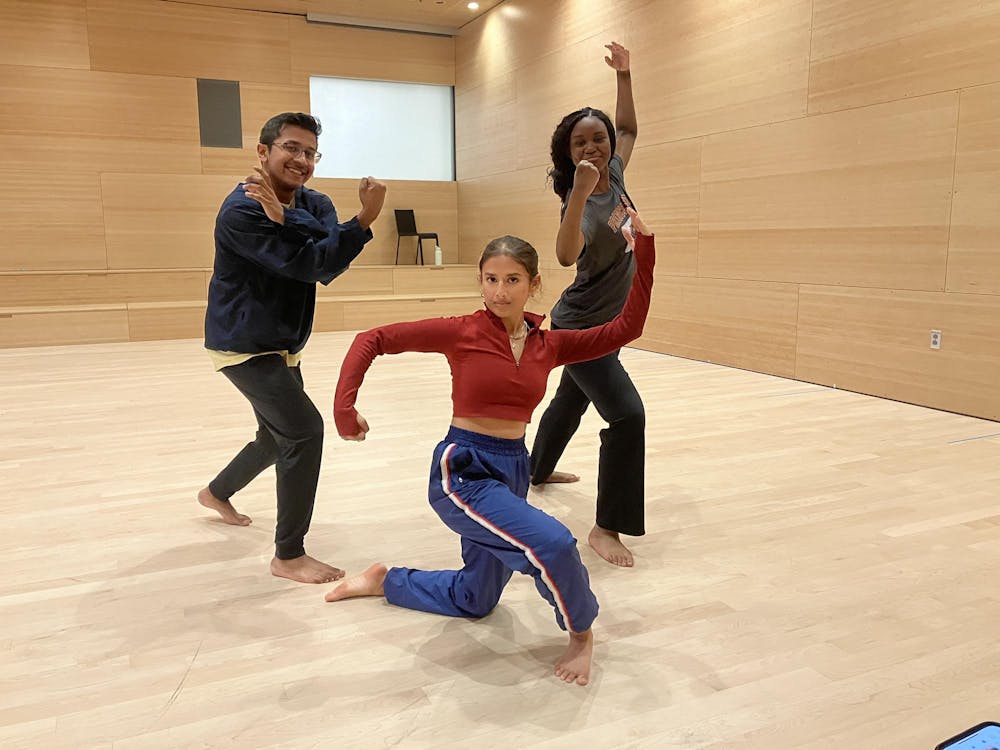Six times a week, members of the Princeton community set aside academics for the arts and gather in a sunlit studio in the Lewis Arts Center to dance. As the teacher counts out the beats, dancers of all levels practice moving to music, disengaging from their work to care for themselves, develop their art, and have fun — and they do this for free.
In addition to the dance minor offered to Princeton undergraduate students, the dance department also offers co-curricular dance classes. These classes are open and free for members of the University community — including students, faculty, staff, and alumni — at all levels of dance experience. Classes were offered this semester in three styles: ballet at the beginner and intermediate levels, hip-hop, and Indian hip-hop fusion.
There are multiple intentions behind co-curricular dance classes: the classes provide additional opportunities for dance minors to practice and are a space for dance exploration for minors and the dance-curious alike.
“We recognize that Princeton students are very busy and that even the most interested dance minor can only take one class a semester,” Susan Marshall, director of the Dance program at Princeton University said in an interview with ‘The Daily Princetonian.’
Marshall added that “a key component to developing your career in dance is to take yourself to class.” Thus, the co-curricular classes give serious dancers an opportunity to develop their technique outside their official dance courses.
However, the co-curriculars also give students of all dance backgrounds a way to explore dance and try out new dance styles.
Marshall says that students should not be intimidated to try a class. Teachers offer modifications in all classes, providing more challenging and simpler options. Students can also speak with the teacher before class.
“Our teachers are prepared to meet with you wherever you are in your dance journey,” she said.

“The teachers are second to none,” Rebecca Ben GS ’19 told the ‘Prince.’
Ben has a significant ballet background and takes “every single class.”
“I was writing my dissertation when I started taking the [co-curricular] classes,” she told the ‘Prince.’ “And it was a very necessary and welcome break to the process.”
Though no warm-up is identical, every class begins with stretches and isolated movements to get the blood flowing and teach the components of that particular dance style. In ballet classes, this happens at the barre; starting with the feet, the class slowly works their bodies into full motion, focusing on balance and positioning. In the hip-hop and Indian fusion hip-hop classes, this warm-up happens on the floor, but with a similar focus on consciously waking the body.

“I’m thinking about warming up in a really holistic way, so kind of isolating from our feet to our fingertips, how to move in different directions, thinking about our body awareness. And then through that, I sort of integrate rhythm and hand gesturology that are specific to all the vocabularies that I integrate. And then that builds sort of basic combinations or sequences of movements that repeat over, let’s say, an eight count,” Ishita Mili, the Indian fusion hip-hop instructor, said in an interview with the ‘Prince.’
Ballet classes progress from barre to floor, where dancers apply the positions and combinations that they practiced at barre to greater sequences of movement. The teacher of the beginners ballet class, Laurie Abramson, also emphasizes body awareness. Sometimes, she pauses between exercises to explain the mechanics of the body’s balance.
Hip-hop and Indian fusion focus on integrating layers of movement and rhythm throughout the entire class.
“Your hips might be, let’s say, doing a figure eight, right to left, while your hands are doing some sort of Mudra, and your eyes are moving in this way, and your feet are keeping a rhythm,” Mili told the ‘Prince’ regarding her fusion class.
Every dance style ends class differently. The Indian fusion class ended with a small choreographed dance, and hip-hop ended with freestyling. Ballet ends with Révérence, a sort of thank you from the dancers to the pianist, who accompanies each ballet class on a baby Steinway piano.
Students enjoy the classes, with 120 people attending a co-curricular class so far.
“I had a lot of fun,” Wasif Sam ’25, a self-described “improvisational mover” who took one of Mili’s co-curricular classes, told the ‘Prince.’ Talking specifically about the Indian fusion class, he said, “I liked the fusion of more grounded movement in our footwork and the airiness and flowiness of our upper body and hands.”
Ben told the ‘Prince,’ “It’s a really wonderful, supportive environment. And people are always happy; there is a place where you can really get away from your classes and just focus on yourself.”
Though some classes will taper down as the semester wraps up and finals loom, ballet classes will continue through the end of the semester, and the last hip-hop class will be on November 16th. Co-curricular dance classes will start again during the spring semester.
Ben remembered even more class offerings prior to the COVID-19 pandemic and hopes that they will expand again as the program continues.
The Dance Department takes student feedback into account when determining what classes to offer in the coming semesters, both as co-curriculars and as official minor classes. Indeed, Marshall said that this feedback influenced the increased hip-hop offerings and Mili’s return as an instructor this semester.
“We’re following the students’ lead,” Marshall said.
Class times and locations can be found on the Lewis Center for the Arts website. No registration or advanced knowledge is required. Classes are free to all members of the Princeton University community.
“I really think this is one of the best offerings that Princeton has,” Ben said.
Annika Plunkett is a contributing writer for The Prospect and a member of the Newsletter team. She can be reached at ap3616@princeton.edu.








